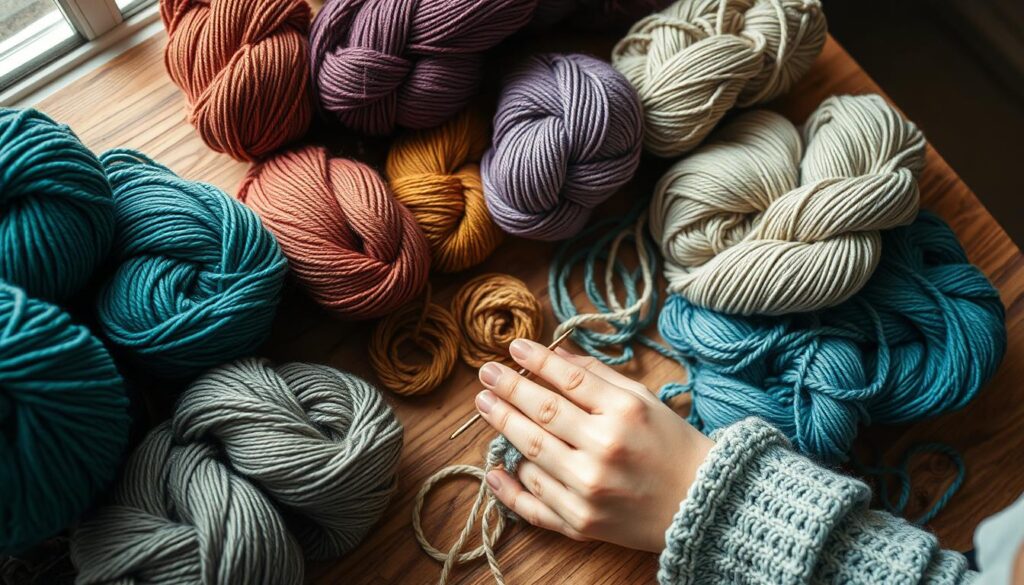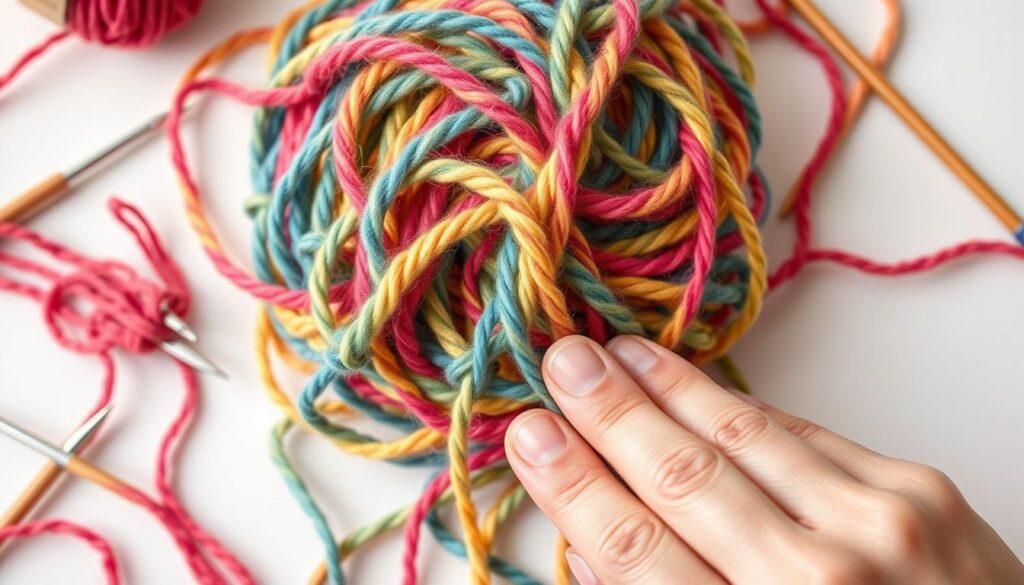
This website uses cookies to ensure you get the best experience on our website. View our Privacy Policy here.

Share this article via:
Please note: This website contains affiliate links. As an Amazon Associate, we earn from qualifying purchases at no additional cost to you.
.
Discover the joy of finger knitting! It’s a simple way to make amazing things with just your hands and yarn. It’s perfect for anyone, whether you’re new to crafting or have been doing it for years.
With finger knitting, you can make things like cozy scarves and soft blankets. It’s also great for making home decor items. It’s easy to learn and very rewarding. Start finger knitting and see what you can create!
Finger knitting is a unique textile art with ancient roots. It doesn’t use needles like traditional knitting. Instead, you use your hands to create unique pieces. This craft has seen a comeback, attracting people of all ages to its hands-on charm.
Finger knitting dates back to ancient times. People used their fingers to weave textiles. It’s been practiced worldwide, from South America to Central Asia. Each culture has added its own twist, making finger knitting a diverse craft.
Finger knitting and needle knitting are different. Finger knitting uses your hands, not needles. This leads to unique textures and patterns not possible with needles.
| Finger Knitting | Needle Knitting |
|---|---|
| Uses hands as the primary tool | Utilizes knitting needles |
| Produces unique textures and patterns | Offers a wider range of stitches and techniques |
| Typically faster project completion | Allows for more intricate and complex designs |
Finger knitting is a fun and easy craft that needs just a few things. The main item is the yarn. When picking the best yarn for finger knitting, think about its weight, texture, and what it’s made of. Beginners often choose bulky or super bulky yarns. They’re easy to work with and make soft, warm projects.
You’ll also need some optional tools for your finger knitting supplies. These include:
While not essential, these tools can make your finger knitting better. The best yarn for beginners is usually soft, chunky wool or acrylic. It moves easily through your fingers.
| Yarn Weight | Recommended Uses |
|---|---|
| Bulky | Scarves, blankets, arm warmers |
| Super Bulky | Quick, cozy projects like cowls and hats |
| Chunky | Versatile for a range of finger knitting projects |
With the right materials, you’ll make beautiful, unique finger-knitted items.

Starting your finger knitting adventure? We’ll walk you through the basics. You’ll learn how to position your hands, make your first stitch, and keep the tension right. This guide will cover the essentials of finger knitting tutorial and how to finger knit for beginners.
First, hold your hands in front of you with palms down. Spread your fingers apart, leaving a small gap. This is the start of your first stitch. It might feel odd at first, but it gets easier with practice.
Keeping your stitches evenly tensioned is key. It makes your fabric look good. Don’t pull the yarn too hard or let it slack. Try different hand positions to find what works best for you.
Learning these beginner knitting techniques is the first step. With time and effort, you’ll make beautiful things with finger knitting. It’s a fun and easy craft to do anywhere.
Finger knitting seems simple, but beginners can still make mistakes. Knowing these common issues helps you fix problems and keep your projects even. This way, you can enjoy making unique, handcrafted items.
One big mistake is uneven tension. This makes your fabric look uneven, with some parts loose and others tight. To fix this, keep your fingers the same distance apart. Also, apply gentle, steady pressure as you work.
Dropped stitches are another common problem. This happens when a loop falls off your fingers before it’s secure. To avoid this, pay attention to how your hands are positioned. Also, keep an eye on the active stitches as you knit.
Tangled yarn can also be a problem for beginners. To avoid this, keep the yarn ball near your work. Also, move smoothly as you knit.
| Common Finger Knitting Mistakes | Solutions |
|---|---|
| Uneven Tension | – Maintain consistent finger spacing and pressure – Avoid sudden movements |
| Dropped Stitches | – Ensure proper hand positioning – Tighten loops after each stitch – Quickly catch any dropped stitches |
| Tangled Yarn | – Keep the yarn ball close to your work – Use smooth, flowing motions |
By knowing and fixing these common mistakes, you can start your finger knitting journey on the right foot. You’ll enjoy making unique, handcrafted items.

Finger knitting is a fun craft that lets you make many beautiful things. It’s great for both beginners and experienced knitters. Let’s look at some popular methods and patterns you can try.
The single-finger technique is perfect for beginners. It uses just one finger to make a simple cord or chain. You can use it to make pretty accessories like bracelets, necklaces, or home decor.
The four-finger method makes thicker, more textured fabric. It’s great for making cozy items like scarves, blankets, or small bags and baskets.
Once you get the hang of basic techniques, try different patterns. You can use stitches like the honeycomb or herringbone to make unique items.
Finger knitting lets you be creative and try many patterns and techniques. Whether you like the simple single-finger method or the versatile four-finger method, you can make lots of beautiful things.
Finger knitting is a great way for beginners to start crafting. With a few basic techniques, you can make many useful and stylish items. Here are some fun ideas to begin your finger knitting adventure:
Making a warm, chunky scarf is one of the simplest finger knitting projects. Using a single-finger method, you can quickly make a soft, cozy accessory for cold days. Try different yarn weights and colors to match your style.
Finger knitted headbands are quick and versatile. They’re great for adding a stylish touch and keeping your ears warm. You can add pom-poms or tassels for extra flair.
Finger knitting is perfect for making unique bracelets. The four-finger technique creates a textured, wearable piece quickly. These bracelets are great gifts or personal treasures.
Finger knitting opens up a world of creativity for beginners. Whether you make cozy scarves, vibrant headbands, or playful bracelets, it’s a fun and rewarding hobby. It’s a great way to explore the world of finger knitting.

Mastering finger knitting takes time and effort. But with the right approach, you can get better and make more detailed projects. These tips will help you improve, whether you’re new or already skilled.
Practice every day to get better at finger knitting. Here are some exercises to help:
As you get better, you might face some problems. Here are solutions for common issues:
Improving at finger knitting takes time and patience. Enjoy the learning, try new things, and keep practicing. With dedication, you’ll see your skills grow.

If you’ve got the basics down, it’s time to try more advanced finger knitting. You can mix it with other crafts or make special accessories. The world of possibilities is vast.
Try mixing finger knitting with macramé, weaving, or crochet. This mix can create amazing, unique pieces. The different textures and methods make for eye-catching items.
There are many advanced stitches to learn. Try the “two-finger” or “three-finger” methods for more complex patterns. These techniques can lead to incredible projects.
| Technique | Description | Recommended Projects |
|---|---|---|
| Two-Finger Knitting | Knitting with two fingers instead of one, creating a tighter, more structured fabric. | Scarves, shawls, and home decor items |
| Three-Finger Knitting | Utilizing three fingers to create a more open, lace-like texture. | Delicate accessories, such as jewelry or decorative items |
| Thumb-and-Finger Knitting | Combining the thumb and a finger to produce a unique, braided effect. | Unique finger knitting accessories, like headbands or bracelets |
Remember, the secret to improving finger knitting is to keep trying new things. Don’t be afraid to experiment and have fun. Let your creativity run wild!
Finger knitting is a fun and rewarding craft. It lets you make beautiful things without needles. We hope this guide made you excited to try finger knitting and show off your creativity.
The finger knitting community is big and growing. There are many resources to help you learn and grow. Look for online forums, videos, and local groups to find new ideas and connect with others.
Keep practicing and trying new things. Finger knitting is a calming activity that brings joy. With hard work and a playful attitude, you’ll get better and make new friends in the finger knitting world. Happy knitting!
Please note: This website contains affiliate links. As an Amazon Associate, we earn from qualifying purchases at no additional cost to you.
.
Share this article via:

This website uses cookies to ensure you get the best experience on our website. View our Privacy Policy here.